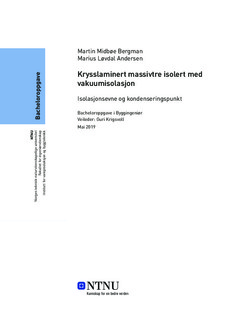| dc.contributor.advisor | Krigsvoll, Guri | |
| dc.contributor.author | Andersen, Marius Løvdal | |
| dc.contributor.author | Bergman, Martin Midbøe | |
| dc.date.accessioned | 2019-09-06T14:01:07Z | |
| dc.date.available | 2019-09-06T14:01:07Z | |
| dc.date.issued | 2019 | |
| dc.identifier.uri | http://hdl.handle.net/11250/2613109 | |
| dc.description.abstract | Fukt er et stort problem i bygningskonstruksjoner, da hele 76% av byggskadene skyldes fukt i ulike former. Fukten er skadelig, fordi det kan føre til soppdannelser og soppskader i konstruksjonen, og det er derfor viktig å isolere godt for å motvirke dette. Det er også et ønske om å benytte tynnere konstruksjoner i bygg, som vil øke sjansen for utviklingen av fukt. Dette blir vanskelig da kravene til U-verdi blir strengere, som egentlig fører til tykkere konstruksjoner ved bruk av konvensjonell isolasjon. Hensikten med oppgaven vår er å undersøke i hvilken grad en konstruksjon av massivtre med vakuumisolasjon vil være utsatt for uheldige fuktnivåer, og eventuelt hvilke faktorer som bidrar til en slik situasjon.
I oppgaven fokuseres det på verdiene for temperatur, relativ fuktighet og vanninnhold, da det gir en god beskrivelse av hvordan materialet blir påvirket. Oppgavens resultater er hentet inn ved hjelp av stasjonære beregninger og dynamiske simuleringer som knyttes opp mot 3 forskningsspørsmål. Disse vil fokusere på hvilke ytre betingelser som kan påvirke veggens fukt- og temperaturgradienter, om variasjon i isolasjonsmengde vil påvirke veggens fukt- og temperaturgradienter og om byggfeil kan ha en påvirkning på temperatur- og fuktforholdene i veggen. De stasjonære betraktningene utføres ved hjelp av dataprogrammet Excel, mens WUFI 2D brukes for de dynamiske simuleringene. Ut i fra betraktningene i Excel brukes det to vegger for videre simuleringer i WUFI, hvor den ene veggen inneholder 100 mm massivtre og 60 mm vakuumisolasjon, mens den andre inneholder 120 mm massivtre og 30 mm vakuumisolasjon.
Simuleringene blir utført for flere uheldige situasjoner der konstruksjonen blir utsatt for høyere fuktnivåer og ugunstige temperaturer. Simuleringene blir gjennomført for de nevnte veggkonstruksjonene og viser grafer for fuktpåkjenning, temperatur og vanninnhold. Grafene viser at fuktinnholdet mellom massivtre og vakuumsjiktet ikke vil forandres, da det ikke vil være en fukttilførsel. De utførte simuleringene gir ingen kritiske situasjoner, som bekreftes gjennom Excel beregningene hvor det ikke vil være noen fare for kondens. | |
| dc.description.abstract | Moisture is a major problem in building constructions. In fact, nearly 76% of building damage is due to moisture in various forms. Moisture causes harmful fungi and fungal damage to the structure. Therefore it is of the upmost importance to insulate well in order to counteract the damaging affects it can have on the building as well as the people exposed. Today we see a desire to use thinner structures in buildings, which will increase the chance of moisture development. However, using thinner constructions in order to allow more space utilization becomes exceedingly difficult. This due to the fact that the U-value requirements are becoming stricter by requiring thicker constructions using conventional insulation. The purpose of our task is therefore to investigate what extent a construction of cross-laminated timber with vacuum insulation will be exposed to adverse moisture levels, and possibly, which factors contribute to such a situation.
The task will focus on the values for temperature, relative humidity and water content, as it gives a good indication of how the material is affected. The results of the assignment are collected using stationary calculations and dynamic simulations that are linked to 3 research questions. These will focus on which external conditions can affect the wall's moisture and temperature gradients, if variation in the amount of insulation will affect the wall's moisture and temperature gradients, and whether building errors can have an influence on the temperature and humidity conditions in the wall. The stationary considerations are performed using the computer program Excel, while the WUFI 2D is used for dynamic simulations. Based on the considerations in Excel, two walls are used for further simulations in WUFI, one wall containing 100 mm cross-laminated timber and 60 mm vacuum insulation, the other containing 120 mm cross-laminated timber and 30 mm vacuum insulation.
The simulations are performed for several unfortunate situations where the construction is exposed to higher humidity levels and adverse temperatures. The simulations are carried out for the mentioned wall structures and show graphs of moisture stress, temperature and water content. The graphs depicting the moisture content between cross-laminated timber and the vacuum layer will not change, as it will not be supplied with moisture. The simulations performed do not give rise to critical situations, which are confirmed by the Excel calculations where there will be no risk of condensation. | |
| dc.language | nob | |
| dc.publisher | NTNU | |
| dc.title | Krysslaminert massivtre isolert med vakuumisolasjon | |
| dc.type | Bachelor thesis | |
